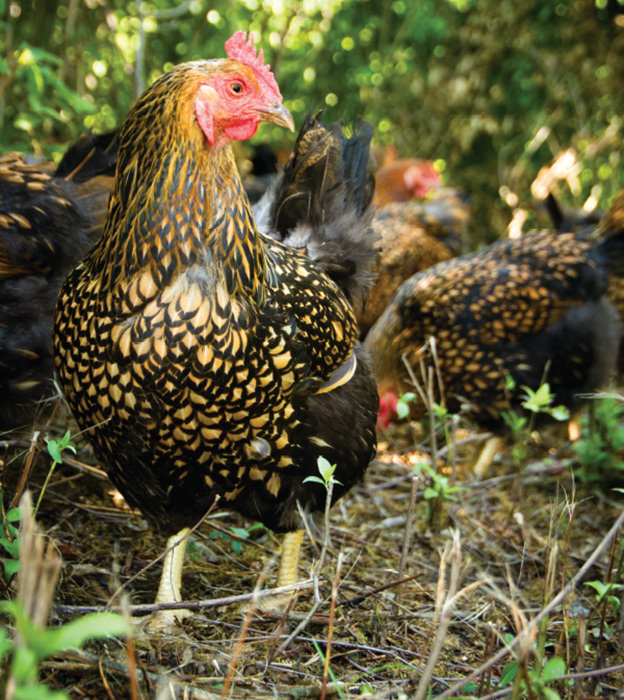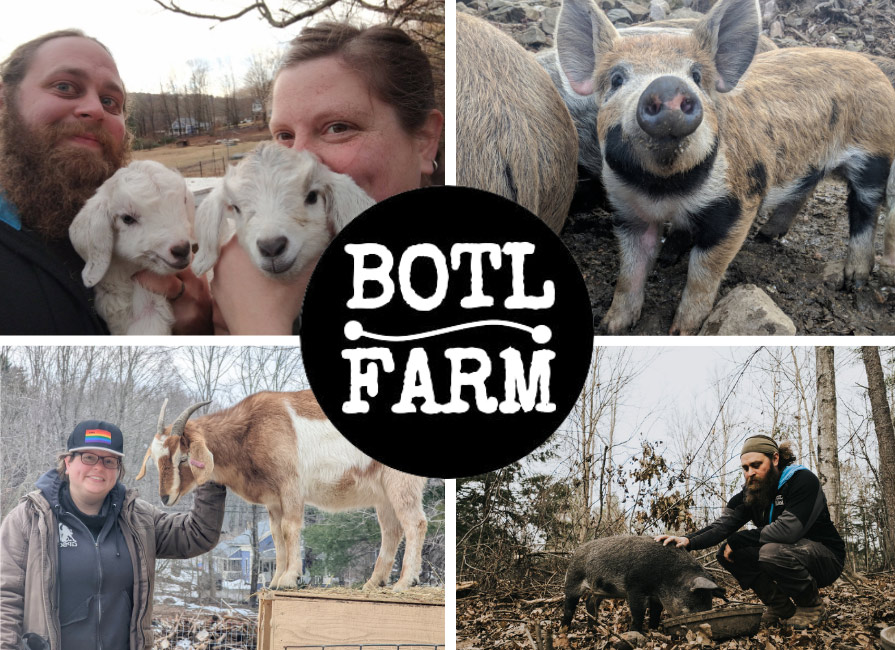Soil nutrient management is a vital part of regenerative farming and applying climate-smart practices can…

Eat Play Shove
The very traits that help our birds thrive on pasture can trigger calamity during the winter months. Understanding what is behind these behaviors can help you adapt for winter wellness and bolster health and well-being during the milder months.
Eat
It is said that top predators live by the principle “eat or be eaten.” For poultry, “eat and don’t get eaten” is probably more accurate. Most poultry are omnivores, persistently combing the range for insects, worms, small rodents and other prey in addition to plant-based foods.
Breeds that are well-suited for pasture are successful foragers because they are innately driven to explore. They turn over leaves, investigate new discoveries by pecking, scratch at freshly turned soil and generally chase things that run away. All of these urges help them find food. But what about safety and social skills?
If size, speed and protective armor are the best defenses against predators, then the picture looks pretty grim for poultry. Geese and turkeys wield their modest size somewhat effectively. Turkeys and guinea fowl are passable sprinters for short distances. Chickens have a pointy beak, if nothing else. All in all, most poultry would be ‘sitting ducks’ if they did not specialize in other tactics to avoid being eaten. What are their options? For farmed fowl, the best bet is to avoid being noticed.
It is normal for ill or injured animals to separate themselves from their group. But for highly vulnerable prey animals, any sign of weakness becomes a beacon for predators. While flock animals like poultry and sheep sometimes choose to self-isolate when distressed, they are more likely to suppress signs of discomfort and seek safety by hiding within the flock. Birds on range use trees, flatbed trailers and housing to hide from aerial predators. When hiding does not work, the backup plan is to move out of reach. Birds may escape into or onto housing and other structures, which offer refuge in the form of obstacles and elevated roosts. While most of their attackers wield sharp teeth or powerful claws, the best weapon of farmed birds is a small pointy stick—and they have to literally stick their neck out to use it. So, you can see why these birds are strongly motivated to move to safety! Even in the absence of predators, birds that cannot act on these natural impulses experience stress as a result.
From the farmer’s perspective, make sure to provide suitable cover (natural or man-made) in the range for birds to hide and explore. Deterrents such as flashy hanging pie tins or CDs, electric fence, motion-activated lights, noisemakers and scarecrows may cause predators to hesitate rather than enter a pen or coop. Guardian animals can also add a strong measure of additional security.
Play
Much of what we call “play” can be viewed as practice for adult life. Even before they can walk without wobbling, hatchlings begin to forage. The habits they learn in their first days and weeks can last a lifetime—and bad habits can bring a lifetime of trouble.
If you give chicks materials they can manipulate, they will quickly learn to peck at wood shavings, leaves, grasses and vegetable matter. If not, their preferred target may become other chicks. For both the aggressors and their victims, it appears that early experience is predictive of future social encounters. Studies have shown that when goslings experience early isolation, or when young chickens get pecked in their first social encounters, they seem to give up on behaviors that help foragers flourish. Bullied birds tend to abandon attempts to access better resources and are more likely to end up with low status in the flock. Youngsters that peck other birds, on the other hand, tend to achieve more dominance in future interactions, and a higher place in the pecking order.
While forming lifelong social habits, lively chicks benefit from enrichment. Consider placing sticks on the floor as perches or hanging bits of string to divert their attention away from milder birds.
Ensure that they are not learning to compete for feed, water, warmth, clean air or prime hiding places. If, for example, water is plentiful but half the waterers are in a drafty location, chicks will compete for access to their favorite source. Exact needs may vary from one chick to the next, so provide a range of temperature zones. If the warmest and coolest zones are sparsely used, your birds are probably comfortable.
Shove
Standing tall, flapping wings noisily, chasing and strutting in circles around another bird are all dominance behaviors. Running away, keeping the head low and hesitating or waiting to approach a feeder, waterer, nest or doorway are deferential behaviors offered by lower-status birds.
Once the pecking order is sorted out, birds tend to avoid repeat altercations by honoring established rankings. But they can only do this if they can recognize each bird in the flock. If group size exceeds their memory capacity, or if new birds are added, confrontations will continue to occur.
Keep ambitious birds busy with litter and enrichments. Add or move perches; supplement with appropriate treats such as vegetables; hang a forage bundle, toy ball or rope. Make sure hanging objects are sized appropriately so that exuberant birds cannot turn them into wrecking balls. Minimize competition by distributing food, water, perches, nests and exits, and make sure your birds can scout all of these from a distance.
Small entry/exit popholes minimize heat loss and drafts, but can represent ambush zones from a bird’s perspective. Narrow openings, obstructions and poor lighting can prevent low-status birds from seeing a clear, safe path, making the pophole a highly stressful place.
Observe behavior: If your birds hesitate or spend extra time scouting or sprint past obstacles, you may need to improve coop layout —or the birds may simply need more space.
How does the indoor foraging and roosting environment affect your poultry? Excessive dust and ammonia can damage the respiratory system, adversely affecting health and growth. Research shows that when birds are unable to escape sub-freezing temperatures, they eat more, grow less and may suffer respiratory damage. Dominant birds select the safest, warmest, freshest spots, so assess thermal comfort and air quality where the meek birds spend their time.
Stress
Remember, too, that low-status individuals also endure the highest day-to-day stress—and direct pressure from dominant birds is only part of the picture. Feather damage and small body size make these birds more prone to heat loss, yet they are relegated to second-choice feed and perch spots. As a result, low-status birds are often forced to choose between safety and comfort. Feisty birds may flourish, but health and behavior at the bottom of the pecking order reveal how well you are meeting your flock’s needs.
Observation
While most animals instinctively suppress signs of pain and suffering, flock animals such as poultry are experts at hiding their discomfort. Do not rely on physical signs of distress in flock animals; day-to-day observation of behavior is your best assessment.
Pay particular attention to low-status birds and record your observations. Obvious physical injuries, such as pecking wounds or frostbite, are signs that your winter management falls considerably short of meeting the flock’s physical and behavioral needs. When rearing young birds, prevent pecking by providing appropriate alternatives. Eliminate competition among adult birds by ensuring adequate access to important resources, safety and comfort.
Poultry health and welfare depend on a com-plex web of factors, with each bird acting on its most urgent individual needs. Poorer pastures, closer quarters, cold weather and other challenges of the winter season can exacerbate stress, reduce immune function and threaten productivity.
The point is not to achieve the bare minimum, so that every choice your birds make hinges on survival and stress management. Rather, our goal is to provide a robust safety net that will sustain health and welfare in the face of changing weather, wildlife disease and other challenges.
If your birds seem like they do not need everything you are offering, that’s great! If they congregate in one roost area, ignoring 90% of the structure you have painstakingly built … if you regularly find five birds crowded into a single cubic foot nest (which is exactly like all the other nests, as far as you can tell), then it is likely that you are meeting many of their needs, much of the time. Well done.
Although the constraints brought by the winter season can feel harsh, this is also a rare chance to resolve issues that are often harder to spot during the growing season. Addressing winter wellness issues will pay dividends by providing a measure of health insurance for your flock year-round.
Jennifer L. Burton DVM is a veterinarian and educator with a special interest in the intersection of food animal medicine and public health.



